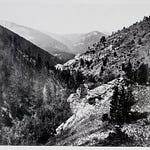THE KOINOS PROJECT is an online educational platform building community through studying community: a place for the intellectually curious, but educatedly stunted searching for something more—for a true mythos. Subscribe now to stay up to date on all our offerings.
Study guide to The Inward Morning by Henry Bugbee pg. 78-102
“It takes many, many days to learn of what may and may not be in the river. Let us wade right in and keep fishing where we are, with our fingertips touching the trembling line. It is just in the moment of the leap we both feel and see, when the trout is instantly born, entire, from the flowing river, that reality is knowingly defined.” pg. 86
In this third installment of our exploration of Henry Bugbee’s “philosophical exploration in journal form,” we dive deep into an image that pervades his text: water.
From the childhood memories discussed in our first episode about building dams, swamping, and rowing to the oceans of World War II and the fished-filled rivers of Montana, it is a theme that Bugbee returns to again and again. It is also an element that has been present since the very origins of philosophy itself, with Thales conceit that water is the fundamental building block of nature and Heraclitus’ claim that “one cannot step into the same river twice.”
Bugbee seems to invoke water in both a literal and metaphorical, even metaphysical sense. The ever-renewing current of the river, the ever-returning ebb and flow of the tide — both somehow encompass his vision of the nature of reality. There is a cyclicaity to the novelty, a way about things that we can come to know by our constant returning and immersion in them. Or to mix metaphors, one must learn to distinguish between the becoming of the river and the being of the riverbed. Yet for Bugbee, not even the riverbed is soilid. Erosion or a chance landslide is constantly reshaping it, requiring us to re-engage and revise our understanding.
This vision of things ultimately undergirds Bugbee’s sense of meaning, values, and responsibility, and the way in which he connects them all together is a wild rapids-ride in itself. So strap in, grab your oar, and come navigate the river Bugbee with us — your life may just well depend upon it.
















